Heinrich J.G., Aldinger F. (Eds.) Ceramic Materials and Components for Engines
Подождите немного. Документ загружается.


This Page Intentionally Left Blank
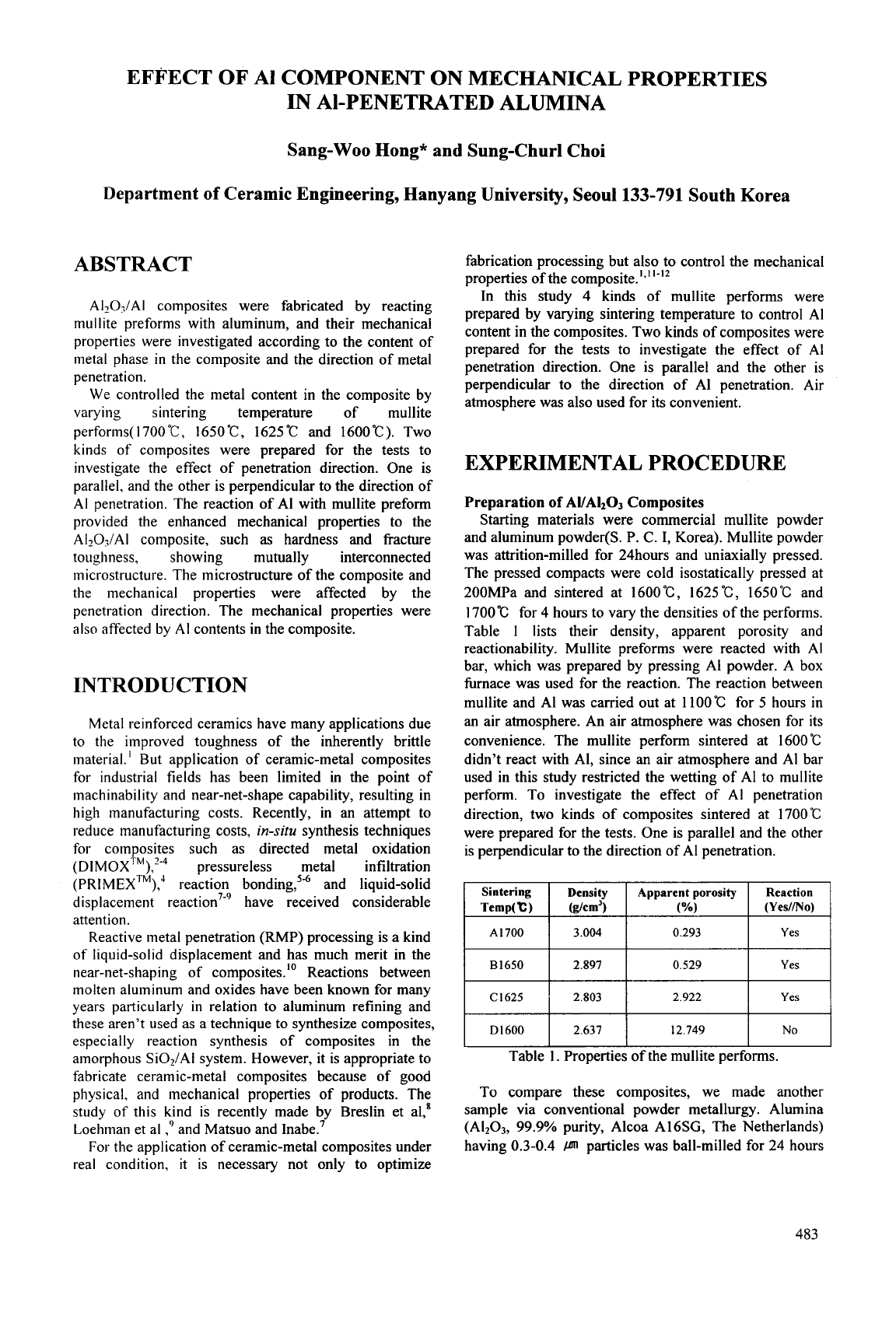
EFFECT
OF
A1
COMPONENT ON MECHANICAL PROPERTIES
IN Al-PENETRATED ALUMINA
Sintering
Temp(C)
A1700
Sang-Woo Hong* and Sung-Churl Choi
Department
of
Ceramic Engineering, Hanyang University, Seoul
133-791
South Korea
Density Apparent porosity Reaction
(dcm')
("/)
(Y
es//No)
3.004
0.293 Yes
ABSTRACT
D1600
AIlO;/AI composites were fabricated by reacting
mullite preforms with aluminum, and their mechanical
properties were investigated according to the content of
metal phase
in
the composite and the direction of metal
penetration.
We controlled the metal content in the composite by
varying sintering temperature of mullite
performs(l700C, 1650C, 1625'C and 1600°C). Two
kinds of composites were prepared for the tests to
investigate the effect of penetration direction. One is
parallel, and the other is perpendicular to the direction of
Al
penetration. The reaction of Al with mullite preform
provided the enhanced mechanical properties to the
A1203/AI composite, such as hardness and fracture
toughness, showing mutually interconnected
microstructure. The microstructure of the composite and
the mechanical properties were affected by the
penetration direction. The mechanical properties were
also affected
by
Al
contents
in
the composite.
2.637 12.749
No
INTRODUCTION
Metal reinforced ceramics have many applications due
to the improved toughness of the inherently brittle
material.
'
But application of ceramic-metal composites
for industrial fields has been limited in the point of
machinability and near-net-shape capability, resulting in
high manufacturing costs. Recently, in an attempt to
reduce manufacturing costs,
in-situ
synthesis techniques
for composites such as directed metal oxidation
(DIMOXTM),'-4 pressureless metal infiltration
(
PRIMEXTM),' reaction bonding,s4 and liquid-solid
displacement have received considerable
attention.
Reactive metal penetration
(RMP)
processing is a kind
of liquid-solid displacement and has much merit in the
near-net-shaping of composites." Reactions between
molten
aluminum and oxides have been known
for
many
years particularly
in
relation to aluminum refining and
these aren't used as a technique to synthesize composites,
especially reaction synthesis of composites
in
the
amorphous Si02/AI system. However, it is appropriate to
fabricate ceramic-metal composites because of good
physical, and mechanical properties of products. The
study of this kind is recently made by Breslin et
a1,*
Loehman et al
,9
and Matsuo and Inabe.'
For the application of ceramic-metal composites under
real condition, it is necessary not only to optimize
fabrication processing but also to control the mechanical
properties ofthe composite.'."-'2
In this study 4 kinds of mullite performs were
prepared by varying sintering temperature to control
A1
content in the composites. Two kinds of composites were
prepared for the tests to investigate the effect of
Al
penetration direction. One is parallel and the other is
perpendicular to the direction of Al penetration. Air
atmosphere was also used for its convenient.
EXPERIMENTAL PROCEDURE
Preparation
of
AVAlzOJ
Composites
Starting materials were commercial mullite powder
and aluminum powder(S.
P.
C.
I,
Korea). Mullite powder
was attrition-milled for 24hours and uniaxially pressed.
The pressed compacts were cold isostatically pressed at
200MPa and sintered at 16OO"C, 1625"C, 1650°C and
1700C for 4 hours to vary the densities of the performs.
Table
1
lists their density, apparent porosity and
reactionability. Mullite preforms were reacted with
Al
bar, which was prepared by pressing A1 powder. A box
furnace was used for the reaction. The reaction between
mullite and Al was carried out at
1
100 'C for
5
hours in
an air atmosphere. An air atmosphere was chosen for its
convenience. The mullite perform sintered at 1600
'C
didn't react with Al, since an air atmosphere and A1 bar
used in this study restricted the wetting of A1 to mullite
perform. To investigate the effect of A1 penetration
direction, two kinds of composites sintered at 1700
"C
were prepared for the tests. One is parallel and the other
is perpendicular to the direction of Al penetration.
B1650
I
2.897
I
0.529
I
Yes
I
C1625
I
2.803
I
2.922
I
Yes
I
To
compare these composites, we made another
sample via conventional powder metallurgy. Alumina
(A1203,
99.9%
purity, Alcoa A16SG, The Netherlands)
having 0.3-0.4
W
particles was ball-milled for 24 hours
483
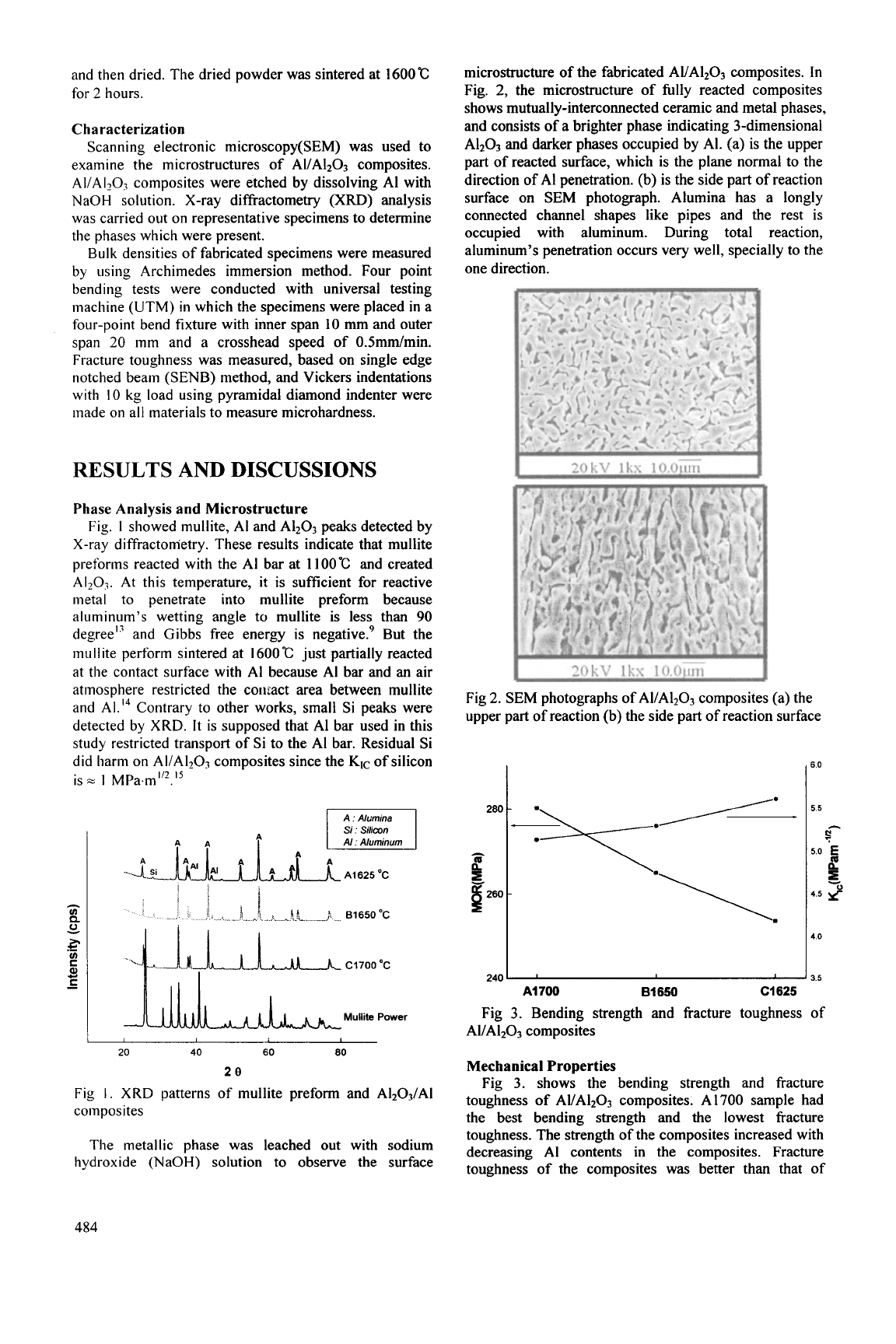
and then dried. The dried powder was sintered at
1600°C
for
2
hours.
Characterization
Scanning electronic microscopy(SEM) was used to
examine the microstructures of AI/A1203 composites.
A1/Al2O3 composites were etched by dissolving A1 with
NaOH solution. X-ray diffractometry
(XRD)
analysis
was carried out on representative specimens to determine
the phases which were present.
Bulk
densities of fabricated specimens were measured
by using Archimedes immersion method. Four point
bending tests were conducted with universal testing
machine (UTM)
in
which the specimens were placed
in
a
four-point bend fixture with inner span
10
mm and outer
span
20
inm and a crosshead speed of O.Smm/min.
Fracture toughness was measured, based on single edge
notched beam
(SENB)
method, and Vickers indentations
with
10
kg
load using pyramidal diamond indenter were
made on all materials to measure microhardness.
RESULTS
AND
DISCUSSIONS
Phase Analysis and Microstructure
Fig.
I
showed mullite, A1 and AI2O3 peaks detected by
X-ray diffractometry. These results indicate that mullite
preforms reacted with the A1 bar at
1
IOO'C
and created
A1203.
At
this temperature, it is sufficient for reactive
metal to penetrate into mullite preform because
aluminum's wetting angle to mullite is less than
90
degree'.' and Gibbs free energy is negative.' But the
mullite perform sintered at
1600°C
just partially reacted
at
the contact surface with
A1
because Al bar and an air
atmosphere restricted the coiiiact area between mullite
and
AI."
Contrary to other works, small Si peaks were
detected by XRD.
It
is supposed that Al bar used in this
study restricted transport of Si to the Al bar. Residual Si
did harm on AI/A1203 composites since the
Kc
of silicon
is
z
1
MPa.m"'.''
20
40
60 80
213
Fig
1.
XRD patterns
of
mullite preform and A1203/AI
composites
The metallic phase was leached out with sodium
hydroxide (NaOH) solution to observe the surface
microstructure of the fabricated AVA1203 composites. In
Fig.
2,
the microstructure of fully reacted composites
shows mutually-interconnected ceramic and metal phases,
and consists of a brighter phase indicating 3-dimensional
A1203 and darker phases occupied by Al. (a)
is
the upper
part of reacted surface, which is the plane normal to the
direction of A1 penetration. (b) is the side part of reaction
surface on SEM photograph. Alumina has a longly
connected channel shapes like pipes and the rest is
occupied with aluminum. During total reaction,
aluminum's penetration occurs very well, specially to the
one direction.
I
20kV
lkx 1O.OG
Fig
2.
SEM photographs of AI/A1203 composites (a) the
upper part of reaction (b) the side part of reaction surface
I
60
55
A
pl
50
E
%
45
2
40
35
A1
700
B1650
C1625
Fig 3. Bending strength and fracture toughness of
Al/A1203 composites
Mechanical Properties
Fig
3.
shows the bending strength and fracture
toughness of AI/A1203 composites. A
1700
sample had
the best bending strength and the lowest fracture
toughness. The strength of the composites increased with
decreasing Al contents in the composites. Fracture
toughness of the composites was better than that
of
484
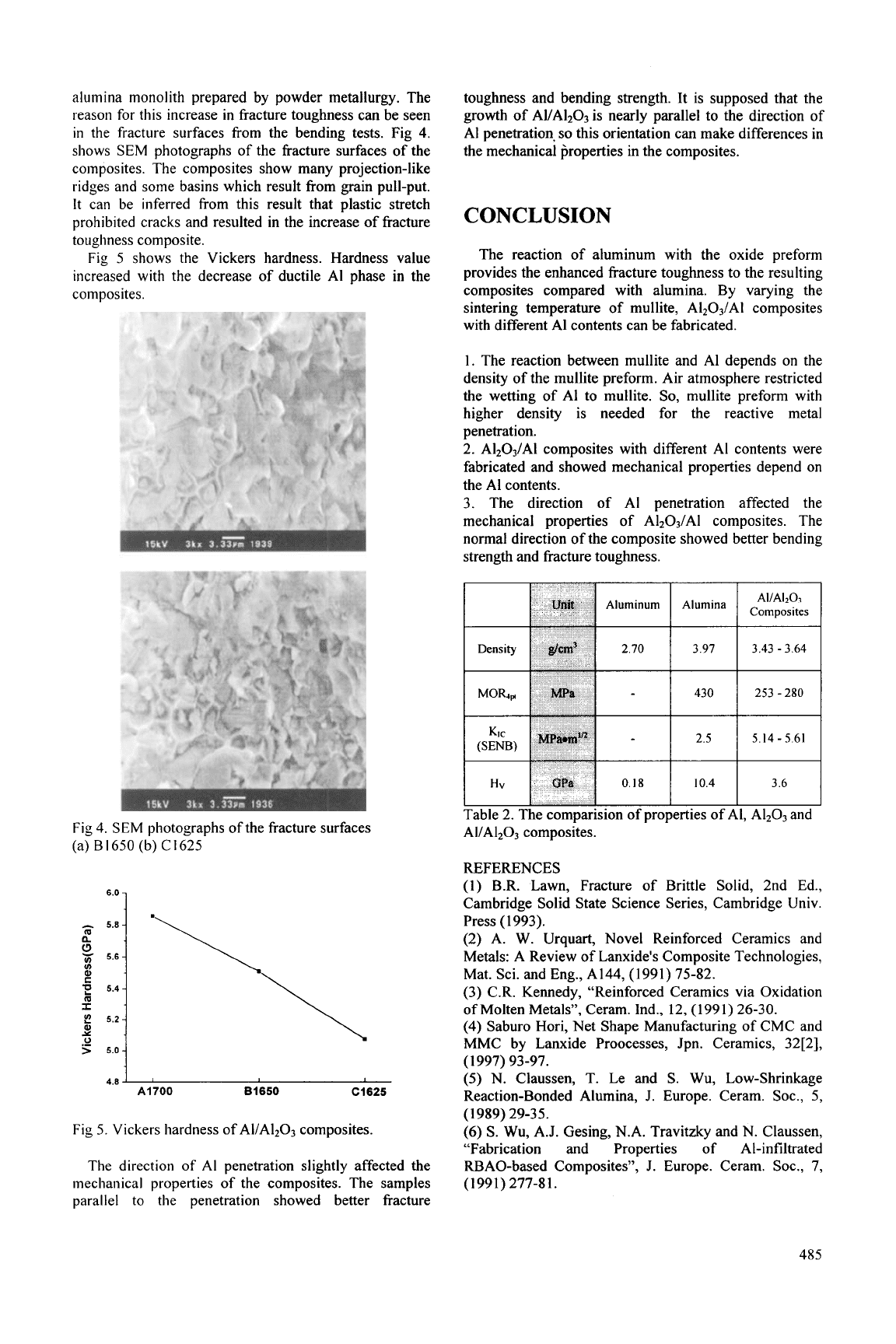
alumina monolith prepared by powder metallurgy. The
reason for this increase in fracture toughness can be seen
in
the fracture surfaces from the bending tests. Fig
4.
shows
SEM
photographs of the fracture surfaces of the
composites. The composites show many projection-like
ridges and some basins which result from grain pull-put.
It
can be inferred from this result that plastic stretch
prohibited cracks and resulted in the increase of fracture
toughness composite.
Fig
5
shows the Vickers hardness. Hardness value
increased with the decrease of ductile Al phase in the
composites.
Fig
4.
SEM
photographs of the fracture surfaces
(a)
B
I650
(b)
C
1625
6.0
1
5.8
-
0
$
5.6
-
u)
Q
a
e
5.4-
m
I
$
5.2-
Y
0
5
5.0
-
4.8
J
‘
A1700
0t65Q
C1625
Fig
5.
Vickers hardness of AI/AI2O3 composites.
The direction of
Al
penetration slightly affected the
mechanical properties of the composites. The samples
parallel to the penetration showed better fracture
toughness and bending strength. It
is
supposed that the
growth of AI/Al2O3 is nearly parallel to the direction of
Al
penetration,
so
this orientation can make differences in
the mechanical properties in the composites.
CONCLUSION
The reaction of aluminum with the oxide preform
provides the enhanced fracture toughness to the resulting
composites compared with alumina. By varying the
sintering temperature of mullite, A1203/AI composites
with different Al contents can be fabricated.
1.
The reaction between mullite and
A1
depends on the
density of the mullite preform. Air atmosphere restricted
the wetting of A1 to rnullite.
So,
rnullite preform with
higher density is needed for the reactive metal
penetration.
2. A1203/AI composites with different
Al
contents were
fabricated and showed mechanical properties depend on
the
Al
contents.
3. The direction of Al penetration affected the
mechanical properties of Al2O3/AI composites. The
normal direction of the composite showed better bending
strength and fracture toughness.
able 2. The comparision of properties of,
Composites
3.43
-
3.64
253
-
280
5.14
-
5.61
,
A1203 and
..
AI/AI2O3 composites.
REFERENCES
(1) B.R. Lawn, Fracture of Brittle Solid, 2nd Ed.,
Cambridge Solid State Science Series, Cambridge Univ.
Press (1 993).
(2) A.
W.
Urquart, Novel Reinforced Ceramics and
Metals: A Review of Lanxide’s Composite Technologies,
Mat. Sci. and Eng., A144, (1991) 75-82.
(3) C.R. Kennedy, “Reinforced Ceramics via Oxidation
of
Molten Metals”, Ceram. Ind.,
12,
(1991)
26-30.
(4) Saburo Hori, Net Shape Manufacturing of CMC and
MMC by Lanxide Proocesses, Jpn. Ceramics, 32[2],
(5)
N. Claussen, T. Le and
S.
Wu,
Low-Shrinkage
Reaction-Bonded Alumina,
J.
Europe. Ceram. SOC.,
5,
(6)
S.
Wu,
A.J. Gesing, N.A. Travitzky and N. Claussen,
“Fabrication and Properties of Al-infiltrated
RBAO-based Composites”,
J.
Europe. Ceram. SOC., 7,
(1997) 93-97.
(1989) 29-35.
(1991) 277-81.
485
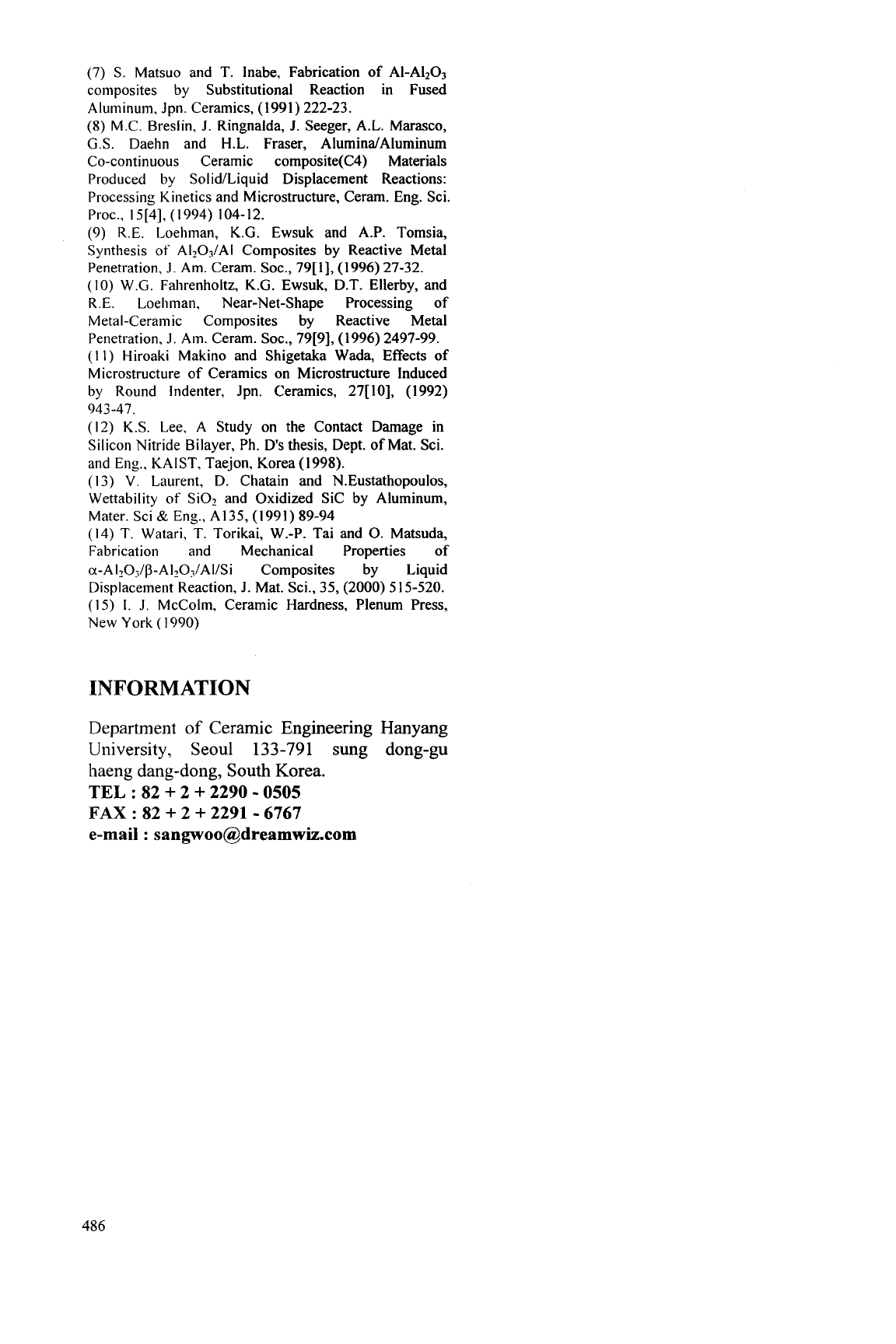
(7)
S.
Matsuo and T. Inabe. Fabrication
of
AI-Alz03
composites by Substitutional Reaction in Fused
Aluminum,
Jpn.
Ceramics, (1991) 222-23.
(8)
M.C. Breslin,
J.
Ringnalda,
J.
Seeger, A.L. Marasco,
G.S.
Daehn and
H.L.
Fraser, Alumina/Aluminum
Co-continuous Ceramic composite(C4) Materials
Produced by Solid/Liquid Displacement Reactions:
Processing Kinetics and Microstructure, Ceram. Eng. Sci.
(9)
R.E.
Loehman,
K.G.
Ewsuk and A.P. Tomsia,
Synthesis
of
A1203/AI Composites by Reactive Metal
Penetration,
J.
Am. Ceram. SOC., 79[
I],
(1996)
27-32.
(10)
W.G.
Fahrenholtz,
K.G.
Ewsuk, D.T. Ellerby, and
R.E.
Loehman, Near-Net-Shape Processing
of
Metal-Ceramic Composites by Reactive Metal
Penetration,
J.
Am.
Ceram. SOC., 79[9],
(1996)
2497-99.
(I
1)
Hiroaki Makino and Shigetaka Wada, Effects
of
Microstructure of Ceramics on Microstructure Induced
by Round Indenter, Jpn. Ceramics, 27[ 101,
(1
992)
943-47.
(12)
K.S.
Lee,
A
Study
on
the Contact Damage in
Silicon Nitride Bilayer, Ph.
Ds
thesis, Dept.
of
Mat. Sci.
and Eng., KAIST, Taejon, Korea (1998).
(1
3)
V.
Laurent,
D.
Chatain and N.Eustathopoulos,
Wettability
of
Si02 and Oxidized Sic by Aluminum,
Mater. Sci
&
Eng., A135, (1991) 89-94
(1
4)
T.
Watari, T. Torikai, W.-P. Tai and
0.
Matsuda,
Fabrication and Mechanical Properties
of
c(-AI20~/P-Al20~/AI/Si Composites by Liquid
Displacement Reaction,
J.
Mat. Sci., 35, (2000)
5
15-520.
(15)
I.
J.
McColm, Ceramic Hardness, Plenum Press,
New York
(
1990)
P~oc.,
15[4], (1994) 104-12.
INFORMATION
Department of Ceramic Engineering
Hanyang
University, Seoul 133-791 sung dong-gu
haeng dang-dong, South
Korea.
TEL
:
82
+
2
+
2290
-
0505
FAX
:
82
+
2
+
2291
-
6767
e-mail
:
sangwoo@dreamwiz.com
486
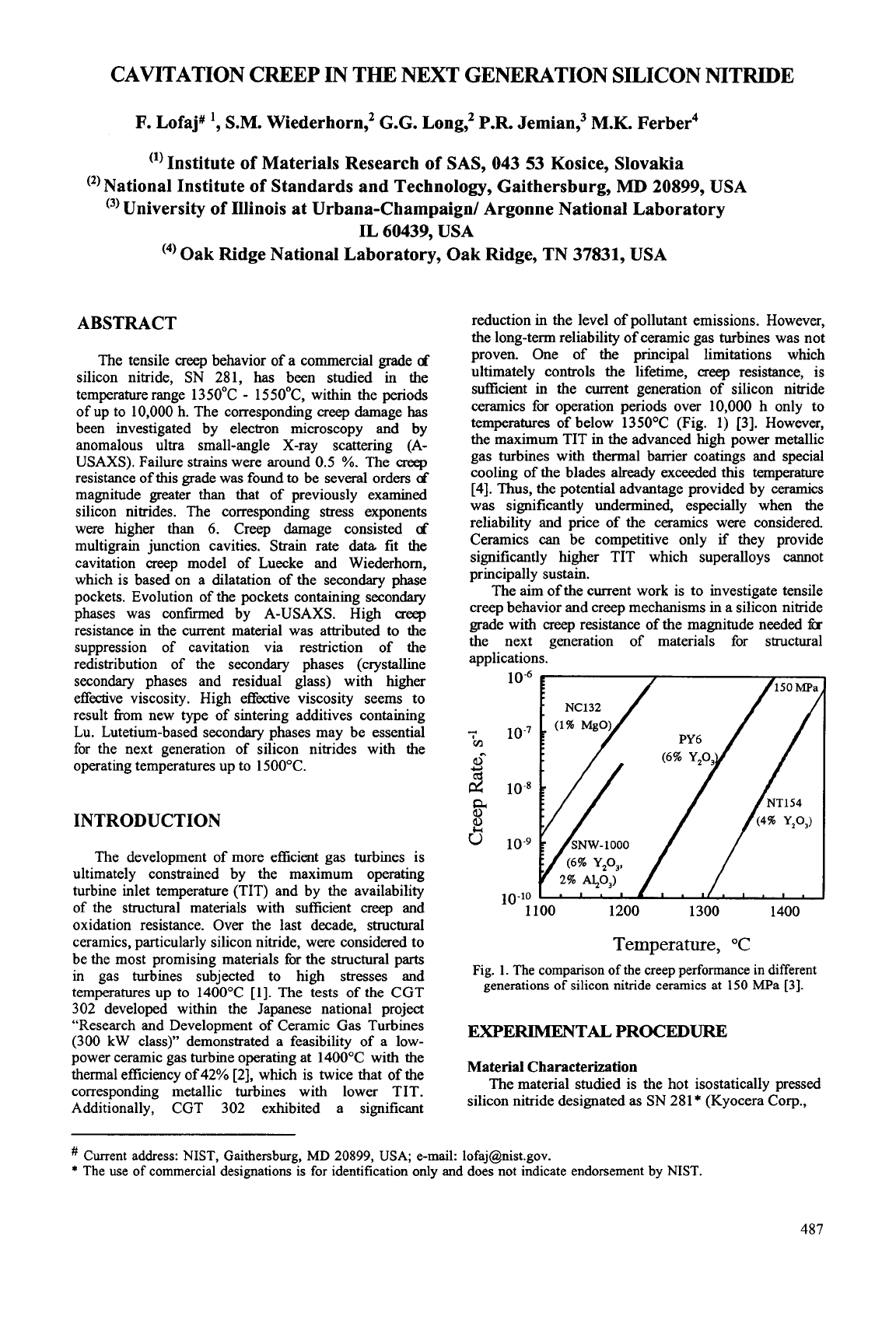
CAVITATION CREEP
IN
THE NEXT GENERATION SILICON NITRIDE
P.
Lofaj#
’,
S.M. Wiederhorn? G.G. Long:
P.R
Jemian? M.K. Ferber4
(l)
Institute of Materials Research of SAS, 043
53
Kosice, Slovakia
(*)
National Institute of Standards and Technology, Gaithersburg, MD 20899, USA
(3) University of Illinois at Urbana-Champaign/ Argonne National Laboratory
IL 60439, USA
(4) Oak Ridge National Laboratory, Oak Ridge, TN 37831, USA
ABSTRACT
The tensile creep behavior of a commercial grade
of
silicon nitride,
SN
281,
has
been studied in
the
temperaturerange 1350°C
-
1550”C, within the periods
of up to 10,000 h. The corresponding creep damage
has
been investigated by electron microscopy and by
anomalous ultra small-angle X-ray scattering (A-
USAXS). Failure strains were around
0.5
%.
The
creep
resistance of
this
grade was found
to
be several orders
d
magnitude greater than that of previously examined
silicon nitrides. The corresponding stress exponents
were higher than
6.
Creep damage consisted
CE
multigrain junction cavities. Strain rate
data.
fit the
cavitation creep model of Luecke and Wiederhom,
which is based on a dilatation of the secondary phase
pockets. Evolution of the pockets containing secondary
phases was
confiied
by A-USAXS. High
creep
resistance in the current material was attributed to the
suppression of cavitation via restriction of the
redistribution of the secondary phases (crystalline
secondary phases and residual glass) with higher
effective viscosity. High effective viscosity seems to
result fiom new type of sintering additives containing
Lu. Lutetium-based secondary phases may be essential
for the next generation of silicon nitrides with
the
operating temperatures up to
1500°C.
INTRODUCTION
The development of more efficient gas turbines is
ultimately constrained by the maximum operating
turbine inlet temperature (TIT) and by the availability
of the structural materials with sufficient creep and
oxidation resistance. Over the last decade, structural
ceramics, particularly silicon nitride, were considered to
be the most promising materials for the structural parts
in gas turbines subjected to high stresses and
temperatures up to 1400°C
[I].
The tests of the CGT
302 developed within the Japanese national project
“Research and Development of Ceramic Gas Turbines
(300
kW class)” demonstrated a feasibility of a low-
power ceramic gas turbine operating at 1400°C with the
thermal efficiency of 42% [2], which is twice that of
the
corresponding metallic turbines with lower TIT.
Additionally, CGT 302 exhibited a significant
reduction in the level of pollutant emissions. However,
the long-term reliability of ceramic gas turbines was not
proven. One of
the
principal limitations which
ultimately controls the lifetime, creep resistance,
is
sufficient in the current generation of silicon nitride
ceramics for operation periods over 10,000 h only to
temperatures of below 1350OC (Fig. 1) [3]. However,
the maximum TIT in the advanced high power metallic
gas turbines with thermal barrier coatings and special
cooling
of
the blades already exceeded this temperature
[4].
Thus,
the
potential advantage provided by ceramics
was significantly undermined, especially when the
reliability and price of the ceramics were considered.
Ceramics
can
be competitive only
if
they provide
significantly higher TIT which superalloys cannot
principally sustain.
The aim of
the
current work is to investigate tensile
creep behavior and creep mechanisms in a silicon nitride
grade with creep resistance of the magnitude needed
6s
the next generation of materials for structural
applications.
LW
10-7
10-8
10-9
1
n-10
-.,
1100
1200
1300
1400
Temperature,
“C
Fig.
1.
The comparison of the creep performance in different
generations
of
silicon nitride
ceramics
at
150
MPa
[3].
EXPERIMENTAL
PROCEDURE
Material Characterization
silicon nitride designated as
SN
281
*
(Kyocera Corp.,
The material studied is the hot isostatically pressed
#/
Current address: NIST, Gaithersburg, MD
20899,
USA;
e-mail: lofaj@nist.gov.
*
The use of commercial designations is for identification only and does not indicate endorsement by NIST.
487

Kyoto, Japan). It consists of SisN4 matrix grains with
the mean diameter of about 1
pm
and aspect ratio 2 to
4, and a small number of the large grains of length up to
30
pm
and diameter
of
3 -6 pm, often containing pore-
like defects and nuclei fiom seeding (Fig.
2).
Secondary
phases in the pockets
are
crystalline and they contain
Lu, which was also reported in the gas-pressure sintered
version of this grade, SN 282 [5]. The mean value
of
the four-point bending strength (3040 mm) at room
temperature is 687d26 MPa; at 1200°C it is
approximately
680
MPa, and 580 MPa at 1400°C [6-71.
Fig.
2.
The microstructure
of
the silicon nitride studied
with typical bimodal grain size distribution.
Tensile Creep Testing
The tensile tests were performed on flat, dog-bone
specimens (SR51 type [8]). The gage size of the
specimens is 2 mm x 2.5 mm and the gage length is 15
mm. They were loaded via single pin Sic pull rods,
lever
arm
and dead weight. Tensile strain was measured
in
situ
using a pair
of
silicon carbide flags suspended by
their own weight on the specimen and laser-
extensometry system [8]. The raw data were recorded by
PC in the interval of
5
min
or
15 min and averaged over
a time period corresponding to 3 to 7 data points.
Details of the testing procedure are described elsewhere
Twenty-one specimens were tested
in
air at 1350"C,
1400"C, 1450"C, 1500°C and 1550°C at the stresses
ranging fiom 150 MPa to 380 MPa and periods up to
10
000
h. Two specimens broke during loading. Three
specimens broke prematurely and the measurement
system failed in three of the tests. Data fiom these
specimens were excluded
from
consideration.
[8-
101.
Microstructure Characterization
The phase composition
of
the specimens was
investigated by X-ray difhction at 40 kV (Cu
K,,
h
=
1.54046
A)
fiom different zones
of
the bulk samples.
The interior of the specimens, revealed by grinding
away half of the specimen thickness, was used
as
a
representative composition for the evaluation of the
changes in the bulk.
The samples for the transmission electron
microscopy (TEM) studies were prepared
hm
fm
creep tested specimens. They were cut from the core
of
gage section parallel to the direction of the applied
stress. After hand grinding and polishing to -100 pm
thickness and dimpling, the foils were thinned by ion
milling at
5
kV using Ar gas until foil perforation.
Transmission electron microscopy investigations
on
carbon coated specimens were carried out at 200 kV and
400 kV.
Creep damage was investigated by a scanning
electron microscope (SEM) on the secondary
fmcttm
surfaces produced at room temperature after creep and on
the polished and plasma etched cross sections.
Anomalous Ultra SmalCAngle X-ray Scattering
Cavity size distribution and the evolution of the
secondary phase pockets were investigated using
anomalous ultra small-angle X-ray scattering on the
beam line 33ID-D at the Advanced Photon Source at
Argonne National Laboratory. The beam incident on the
sample was monitored by an ionization chamber. The
beam scattered by the sample was detected by a silicon
PIN photodiode operating in an unbiased mode. The
details of the USAXS instrument were reported
elsewhere
[
1
I].
The samples with the dimensions of 2.5 mm x 4
mm x
0.15
mm were prepared fiom the as-received
material and hm the gage and grip zones of three
specimens after creep. The grip-gage pairs of specimens
were used to eliminate the effects of initial porosity and
possible changes in the microstructure during prolonged
heat treatment on cavity and pocket size distributions.
Data collection fiom USAXS scan for each specimen
required approximately 20 min with a
5
s
counting time
per data point. The iterative method of Lake was used
to desmear the data [12].
The anomalous USAXS technique involves
measurement at -250 eV,
-100
eV, -40 eV and
-10
eV
below the
LIII
absorption edge energy, which is 9244 eV
for Lu. The presence of LuaSi207 as the secondary phase
was assumed in the calculations. The details of the A-
USAXS technique and evaluation method were reported
elsewhere
[
131.
RESULTS
Creep Behavior
Fig. 3 shows the long-term tensile creep behavior
of
the material at 1400°C under the stress of
200
MPa.
The
test
was interrupted prior
to
failure after 10,200 h.
During this period, the test was interrupted once due to
the power outage. The total strain is around
0.5
%,
however, due to the several failures in the data
collection, an uncertainty of
>
0.1% is included.
Despite that, the transient stage exceeds
6000
h azd
the
strain rate after this period is less than
1
x
10-
I/s,
close to the limit of the laser extensometer resolution. A
conservative estimate
of
the minimum strain rate at
these conditions is
7
x
lo-"
l/s. Similar transient creep
was observed at 1450°C. The short-term tests at
1550°C indicated conventional creep behavior with the
primary and secondary stages. However, these data were
affected
by the oxidation of the Sic pull rods which
form glass bubbles which interact with the laser beam.
Because of prolonged lifetime, the number of tests
performed until fmal failure was limited. Stress
dependence of the minimum strain rate fiom the tests
unaffected by premature failure is summarized in Fig. 4.
It can be seen that the stress exponent exceeds 6.
488
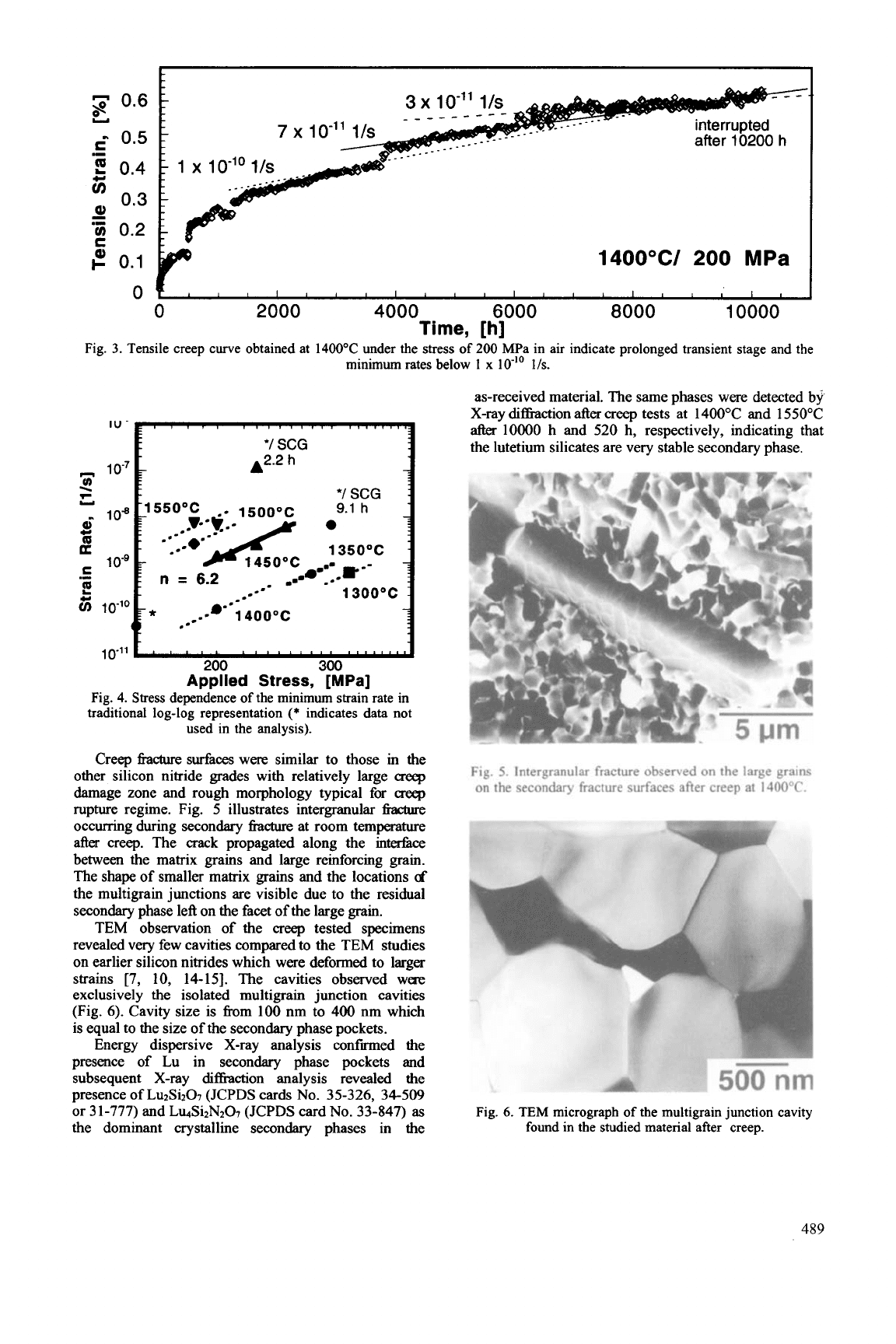
t
___---
7
in-11
41-
I-“
0.1
14OO0C/
200
MPa
0
I
I
I, I
I,
0
2000
4000
6000
8000
10000
Time,
[h]
Fig.
3.
Tensile creep curve obtained at 140OOC under the stress of
200
MPa in air indicate prolonged transient stage and the
minimum rates below
1
x 10”
Us.
IU
-
-
10-7
u)
\
L
i
10“
1
09
d
3i
10’0
4-
E
.-
E
10’’
.
. . . . .
.
.
.
. . . .
.
. .
. .
.
.
*I
SCG
A2.2
h
*I
SCG
II
=
6.2
..--
135OOC
iooc
*..N;:m--
13OOOC
*
..-I
4OOOC
I
200
300
Applied
Stress,
[MPa]
Fig. 4. Stress dependence of the minimum strain rate in
traditional log-log representation
(*
indicates
data
not
used in the analysis).
Creep
hcture
surfaces were similar to those in
the
other silicon nitride grades with relatively large
creep
damage zone and rough morphology typical for
creep
rupture regime. Fig.
5
illustrates intergranular
!?actme
occurring during secondary
hcture
at room temperature
after creep. The
crack
propagated along the interhce
between the matrix grains and large reinforcing grain.
The shape of smaller matrix grains and the locations
CE
the multigrain junctions are visible due to the residual
secondary phase left on the facet of the large
grain.
TEM observation
of
the
creep
tested specimens
revealed very few cavities compared to the TEM studies
on earlier silicon nitrides which were deformed to larger
strains [7, 10, 14-15]. The cavities observed were
exclusively the isolated multigrain junction cavities
(Fig. 6). Cavity size is hm 100 nm to 400 nm which
is equal to the size of the secondary phase pockets.
Energy dispersive X-ray analysis confmed the
presence of Lu in secondary phase pockets and
subsequent X-ray difE-action analysis revealed the
presence of Lu2Si207
(JCPDS
cards
No.
35-326,
34-509
or
3
1-777) and LuSi2N207
(JCPDS
card
No.
33-847)
as
the dominant crystalline secondary phases in the
as-received material. The same phases were detected by
X-ray diWon
&er
creep
tests at
1400°C
and
1550°C
after
10000 h and
520
h, respectively, indicating that
the lutetium silicates are very stable secondary phase.
Fig.
5.
Intergranular fracture observed on the large grains
on
the
secondary
fracture
surfaces after creep
at
1400OC.
Fig.
6.
TEM
micrograph
of
the multigrain junction cavity
found in
the studied material after creep.
489
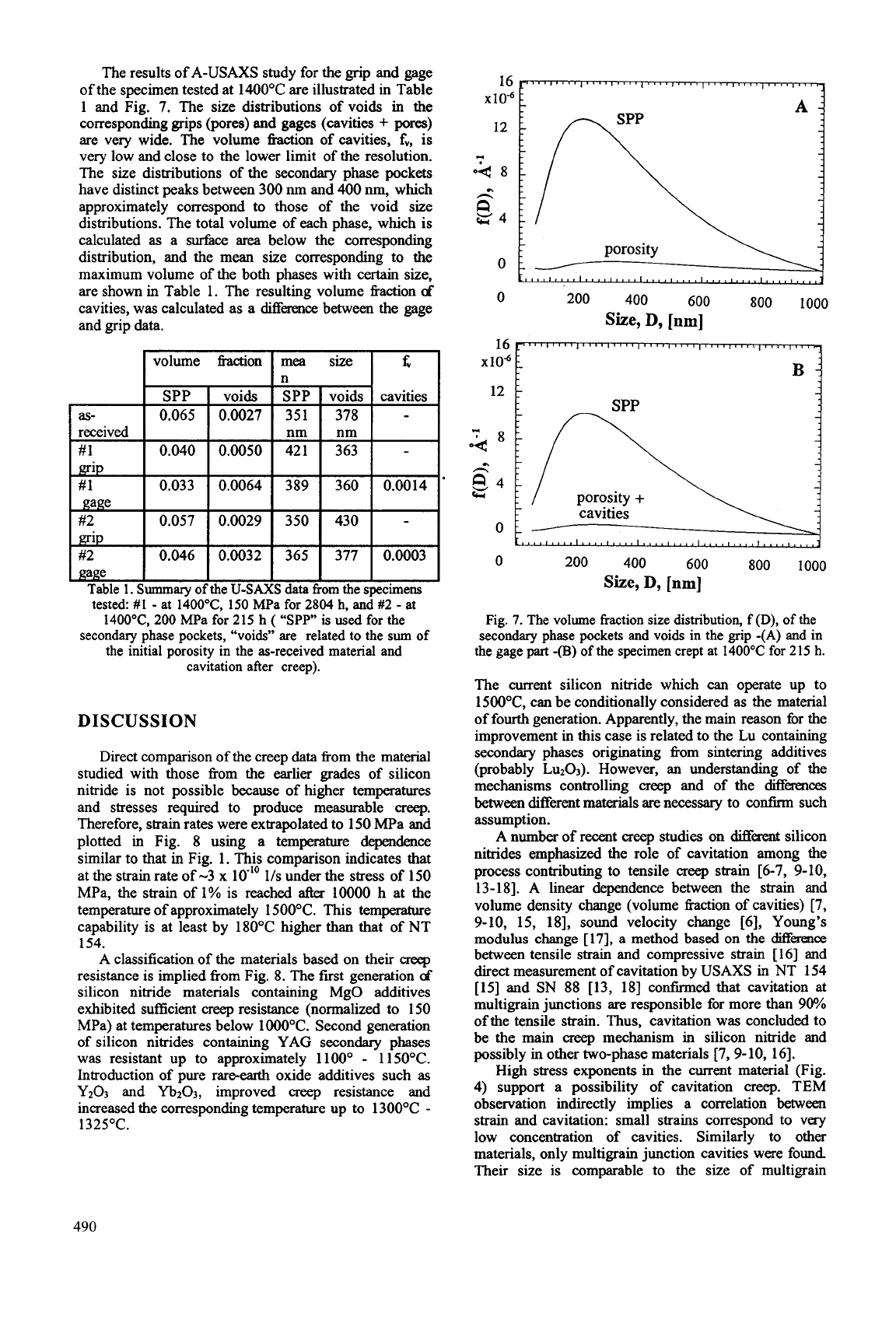
The results of
A-USAXS
study for the grip and gage
of
the specimen tested at 1400°C are illustrated in Table
1 and Fig. 7. The size distributions
of
voids in the
corresponding grips (pores) and gages (cavities
+
pores)
are very wide. The volume tiaction of cavities, fv, is
very low and close to the lower limit of the resolution.
The size distributions of the secondary phase pockets
have distinct
peaks
between 300
nm
and 400
nm,
which
approximately correspond to those of the void size
distributions. The total volume of each phase, which is
calculated
as
a
surface
area
below the corresponding
distribution, and the mean size corresponding to the
maximum volume of the both phases with certain size,
are shown in Table 1. The resulting volume fiaction
d
cavities, was calculated as a
difference
between the gage
and grip data.
as-
volume Mon mea size
f
n
SPP
I
voids
SPP
I
voids cavities
0.065
I
0.0027 351
I
378
received
#1
grip
#1
gage
I I I I
I
#2
I
0.057
I
0.0029
I
350
I
430
I
nm nm
0.040
0.0050
421 363
0.033 0.0064 389 360 0.0014
grip
#2
gage
I
I
I I
I
I
Table
1.
Summary of the
U-SAXS
data
from the specimens
tested
#1
-
at 1400"C,
150
Ma for 2804
h,
and #2
-
at
14OO0C,
200
MPa for
215
h
(
"SPP" is
used
for the
secondary phase pockets, "voids" are related to the sum of
the initial porosity in the as-received material and
cavitation after creep).
0.046 0.0032 365 377 0.0003
DISCUSSION
Direct comparison
of
the creep data from the material
studied with those from the earlier grades of silicon
nitride is not possible because of higher temperatures
and stresses required to produce measurable creep.
Therefore, strain rates were extrapolated to 150 MF'a and
plotted in Fig. 8 using a temperature
dependence
similar
to
that in Fig. 1. This comparison indicates that
at the strain rate of -3 x 10"' Us under the
stress
of
150
MPa, the strain
of
1% is reached
after
10000
h at the
temperature
of
approximately 1500°C. This temperature
capability is at least by 180°C higher than that of NT
154.
A
classification
of
the materials based on their
mq
resistance is implied from Fig.
8.
The first generation
d
silicon nitride materials containing MgO additives
exhibited sufficient
creep resistance (normalized to 150
MPa) at temperatures below 1000°C. Second generation
of silicon nitrides containing
YAG
secondary phases
was resistant up to approximately 1100"
-
1150°C.
Introduction of pure rare-earth oxide addltives such
as
Y203
and
Yb203,
improved
creep
resistance and
increased the corresponding temperature up to 1300°C
-
1325°C.
-1
h
a"4
iz
0
0
Fig. 7. The volume fraction size distribution,
f
(D),
of the
secondary phase pockets and voids in the grip
-(A)
and
in
the gage part
-(B)
of the specimen crept at
1400°C
for 215 h.
The current silicon nitride which can operate up to
1500"C, can be conditionally considered as the material
of
fourth
generation. Apparently, the main reason for the
improvement in this case is related to the Lu containing
secondary phases originating from sintering additives
(probably LuzO~). However, an understanding of the
mechanisms controlling creep and of the
Wmca
between different materials are necessary to
confirm
such
assumption.
A number of recent creep studies on
difkent
silicon
nitrides emphasized
the
role of cavitation among the
process contributing to tensile creep strain [6-7, 9-10,
13-18].
A
linear dependence between the strain and
volume density change (volume hction
of
cavities) [7,
9-10, 15, 181, sound velocity change [6], Young's
modulus change
[
171, a method based on the
difference
between tensile strain and compressive strain
[
161 and
direct measurement
of
cavitation by
USAXS
in NT 154
[15] and SN 88 [13, 181 confirmed that cavitation at
multigrain junctions
are
responsible for more than 90%
of the tensile strain. Thus, cavitation was concluded to
be the main
creep
mechanism in silicon nitride and
possibly in other two-phase materials [7,9-10, 161.
High stress exponents in
the
current material (Fig.
4) support a possibility of cavitation creep. TEM
observation indirectly implies a correlation between
strain and cavitation: small strains correspond to very
low concentration of cavities. Similarly to other
materials, only multigrain junction cavities were found
Their size is comparable to the size of multigrain
490
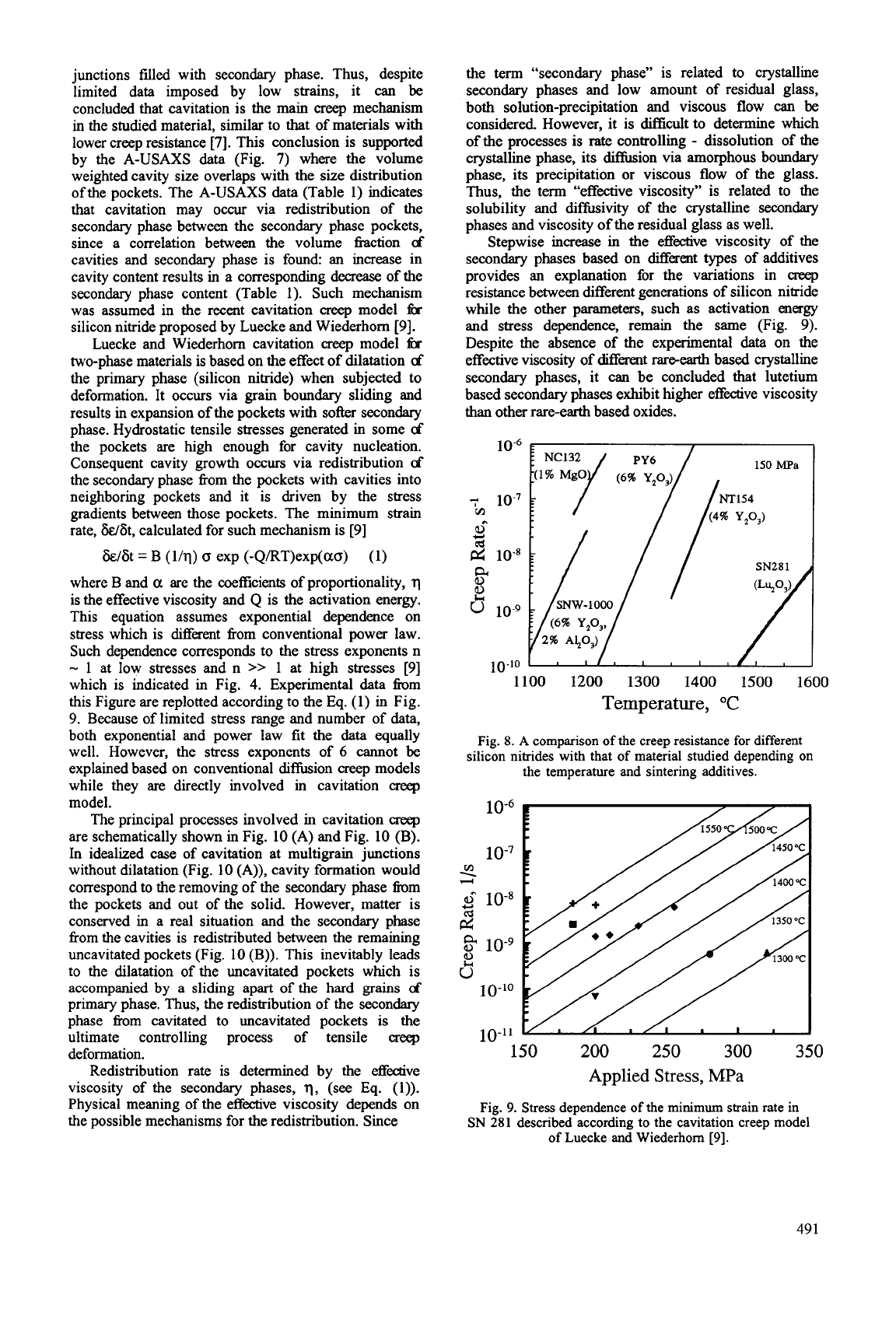
junctions filled with secondary phase. Thus, despite
limited data imposed by low strains, it
can
be
concluded that cavitation is the main
creep
mechanism
in the studied material, similar to that of materials with
lower creep resistance
[7].
This conclusion is supported
by the
A-USAXS
data (Fig.
7)
where
the
volume
weighted cavity size overlaps with the size distribution
ofthe pockets. The
A-USAXS
data (Table 1) indicates
that cavitation may
occur
via redistribution of the
secondary phase between the secondary phase pockets,
since a correlation between the volume fraction
of
cavities and secondary phase is found an increase in
cavity content results in a corresponding
decrease
of the
secondary phase content (Table
1).
Such mechanism
was assumed in the recent cavitation
creep
model
i?r
silicon nitride proposed by Luecke and Wiederhorn [9].
Luecke and Wiederhorn cavitation
creep
model
i?r
two-phase materials is based on the effect of dilatation
d
the primary phase (silicon nitride) when subjected to
deformation. It occurs via grain boundary sliding and
results
in
expansion of the pockets with
soh
secondary
phase. Hydrostatic tensile stresses generated in some
d
the pockets are high enough for cavity nucleation.
Consequent cavity growth occurs via redistribution
of
the secondary phase fiom the pockets with cavities into
neighboring pockets and it is driven by the stress
gradients between those pockets. The minimum strain
rate, M6t, calculated for such mechanism is [9]
&/at
=
B
(l/q)
(T
exp (-Q/RT)exp(ao)
(1)
where B and
01
are the coefficients of proportionality,
q
is the effective viscosity and
Q
is the activation energy.
This equation assumes exponential dependence on
stress which is different fiom conventional power law.
Such dependence corresponds to the stress exponents n
-
1 at low stresses and n
>>
1 at high stresses [9]
which is indicated in Fig.
4.
Experimental data hm
this Figure are replotted according to the Eq. (1) in Fig.
9.
Because of limited stress range and number of data,
both exponential and power law
fit
the data equally
well. However, the stress exponents of
6
cannot
be
explained based on conventional dihion creep models
while they are directly involved in cavitation
creep
model.
The principal processes involved in cavitation
creep
are schematically shown in Fig. 10
(A)
and Fig. 10
(B).
In idealized case of cavitation at multigrain junctions
without dilatation (Fig. 10
(A)),
cavity formation would
correspond
to
the removing of the secondary phase hm
the pockets and out of the solid. However, matter is
conserved in a real situation and the secondary phase
fiom the cavities is redistributed between the remaining
uncavitated pockets (Fig. 10 (B)). This inevitably leads
to the dilatation of the uncavitated pockets which is
accompanied by a sliding apart
of
the
hard
grains
cf
primary phase. Thus, the redistribution of the secondary
phase hm cavitated to uncavitated pockets is the
ultimate controlling process of tensile
creep
deformation.
Redistribution rate is determined by the
effective
viscosity of the secondary phases,
q,
(see Eq.
(1)).
Physical meaning of the effective viscosity depends on
the possible mechanisms for the redistribution. Since
the term “secondary phase” is related to crystalline
secondary phases and low amount of residual glass,
both solution-precipitation and viscous flow
can
be
considered. However, it is difficult to determine which
of the processes is
rate
controlling
-
dissolution
of
the
crystalline phase, its diffusion via amorphous boundary
phase, its precipitation or viscous flow of the glass.
Thus, the term “effitive viscosity” is related to the
solubility and diffusivity of the crystalline secondary
phases and viscosity of the residual glass as well.
Stepwise increase in the effective viscosity
of
the
secondary phases based on different types of additives
provides an explanation for the variations in
creep
resistance between different generations of silicon nitride
while the other
parameters,
such as activation energy
and stress dependence, remain the same (Fig. 9).
Despite the absence of the experimental data on the
effective viscosity of different rareearth based crystalline
secondary phases, it can be concluded that lutetium
based secondary phases exhibit higher effective viscosity
than
other rare-earth based oxides.
1100
1200
1300
1400
1500
1600
Temperature,
“C
Fig.
8.
A
comparison of the creep resistance for different
silicon nitrides with that of material studied depending
on
the temperature and sintering additives.
3
10-9
G
b)
10-l0
lo-”
150
200
250
300
350
Applied Stress,
MPa
Fig.
9.
Stress dependence
of
the minimum strain rate in
SN
281
described according to the cavitation creep model
of
Luecke and Wiederhorn
[9].
49
1
